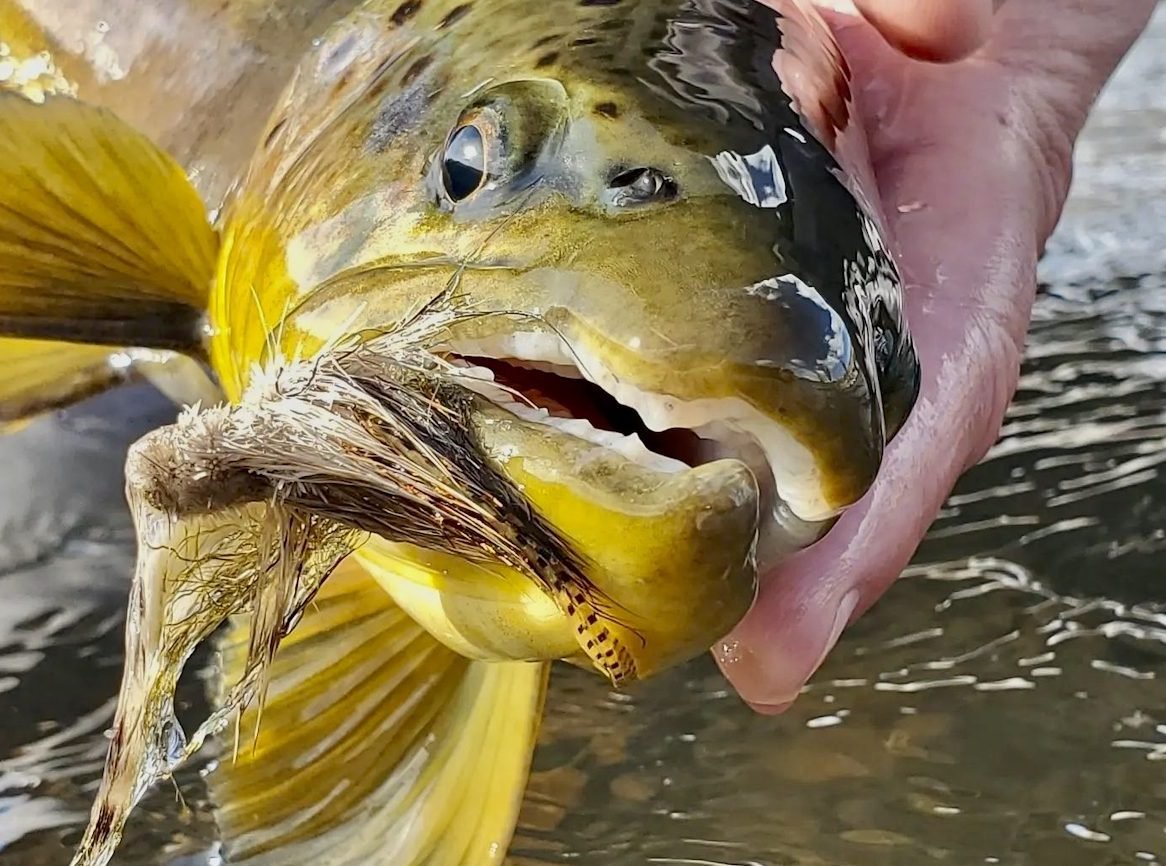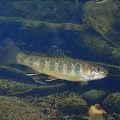Slinging Meat: How to Fish Giant Streamers

Image by Mike Doughty
Every fly angler wonders what lies beneath. Out on our favorite rivers, where we may have caught hundreds of trout in the past, we wonder if there’s some monstrous trout lurking in the shadows of our favorite runs and pools that’s always been just out of reach. Eventually it becomes a question that needs to be answered and, aside from packing a harpoon out onto the river with us, there’s only one real way to try and catch that behemoth of a trout we dream about—fishing with giant streamers.
Taking up the big streamer game can be a challenge. The tight loops and delicate presentations that took years for us to learn are exchanged for big, splashy casts and chaotic, almost violent presentations. It’s fly fishing that goes against almost every instinct we have as fly fishers. But when we do it right, it is the absolute best way to target and catch the biggest trout in the river.
Beefing Up Your Gear
Fishing big streamers means casting a fly with all the aerodynamics and water absorption of a Christmas stocking and stripping it through heavy currents while getting hung up on rocks and logs along the way.
A heavier 6-weight to an 8-weight fly rod is a vital tool for fishing with big flies as they give you more backbone and casting power. You’ll also want a heavy duty, large arbor streamer reel that has a half-decent disc drag system and enough room for a thicker, heavier fly line. Select a line with some bulk such as double taper or even a power taper shooting head line that will easily turn over big streamers. A line with built-in sink tip is also a good idea as it can help get weighted flies down to the bottom and can even help to keep your unweighted flies in the strike zone with little effort. You’ll also want to grab a few spools of heavier, 10-20-pound tippet to help you hang onto larger fish and pull flies free from snags.
Smack’em Down
One of the most difficult things for new sizeable streamer anglers to understand is that you don’t need to, nor do you want to be delicate. Large trout are dominant and territorial predators that don’t spook easily. And, like sharks, they’re even attracted to noise and vibrations on the surface of the water. As such, casting and fishing streamers gently, like you would a dry fly, just isn’t the way to go. Instead, cast and fish big streamers with a lot of explosiveness and movement behind them so that they make a big impact on both the water and the fish.
When casting a big streamer, you’re trying to make a big splash. In fact, much of the time, just splashing a meaty fly down on the water is enough to trigger a big hungry trout to come rocketing out of its dark hole and absolutely crush your bug. The best way to do this is with a Belgian cast. Unlike a typical, tight-looped, pretty-as-a-picture fly cast, a Belgian cast is a wide-open, arm-flinging type of cast akin to lobbing a grenade into a foxhole. It consists of making a sharp, side-arm back cast and then coming back forward over the top with your shoulder so that the fly pendulums and smashes down into the water. Doing it correctly means that your rod is traveling in sort of an oval with the line remaining tight throughout the cast. It can take a bit of practice as you have to almost unlearn everything you were taught about fly casting. But once you’ve got the Belgian cast down, there’s no better way to get a big fish to sit up and pay attention to your streamers.
Aside from splatting down your fly down like a pumpkin off an overpass, you can also draw a lot of attention to your streamer by twitching and jerking it as you fish. Too often anglers get stuck into the repetitive rhythm of casting and stripping their streamers back to them like mindless fishing robots. While this can work on occasion, adding a bit of song and dance to the retrieve will work even better. Instead of just stripping the fly, break up your cadence by adding in short, quick switches, hard tugs, and even long pauses with your rod tip. This puts more vibration and action into the water and makes your streamer look and act more like a wounded baitfish. Fishing a streamer this way is almost sure to cause a big predatory trout to come over to see what’s causing all the commotion.
Running Down Hill
One of the most important things to remember when fishing big streamers is to retrieve your flies downstream. Just as a lion is hesitant to chase a wildebeest up a hill, so too are big trout less likely to pursue a streamer fished against the current. They prefer to take an easier route. So while many anglers cast and retrieve their streamers against the flow or by swinging them across the stream, you’ll have much better luck by casting upstream and then working your flies downstream.
It’s important to remember that the largest trout are the laziest trout. They’ve been in the river for years and know where to rest and how to feed with the least amount of effort. Catching them means targeting the laziest looking spots and then making your fly into an easy mark. Cast your streamers at an upstream angle and smack them down into slow-moving water that’s close to the bank or around rocks and snags where big trout like to hide. If you don’t get an immediate strike, retrieve the fly by stripping and twitching it down and across the current into faster moving water. This will present your streamer as a wounded and/or vulnerable fish that’s trying to make a quick getaway and just like a grizzly instinctively charging after a sprinting hiker, a big trout won’t be able to resist running it down.
Trophy Hunting
Fishing giant streamers is one of the strangest things you can do with a fly rod. It’s not the most productive way to catch a trout as you’ll often go hours and even days without a strike because there simply aren’t a lot of giant trout out there. In addition, the method itself seems to smash against the very foundations of the graceful and delicate art of fly fishing itself with its abrasive movements and completely monstrous flies. But when that burning question about just how big a trout can get needs to be answered, you’ve got to send a monster to catch a monster—graceful art be damned.











